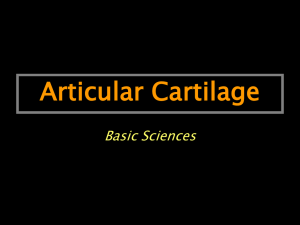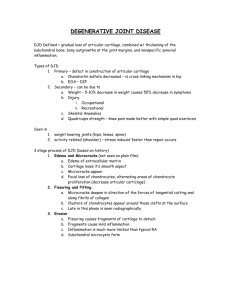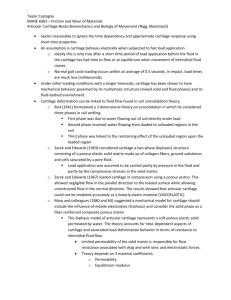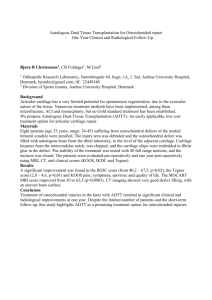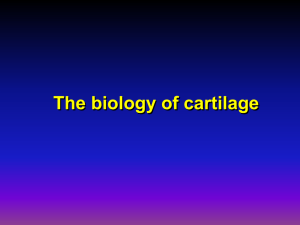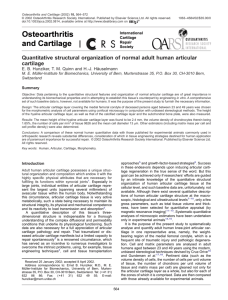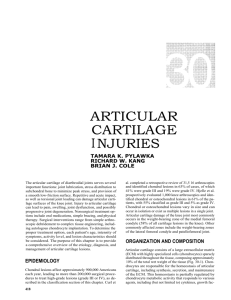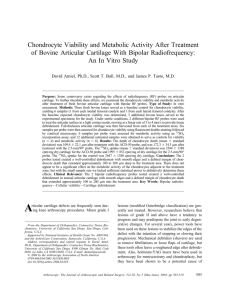Articular Cartilage
advertisement
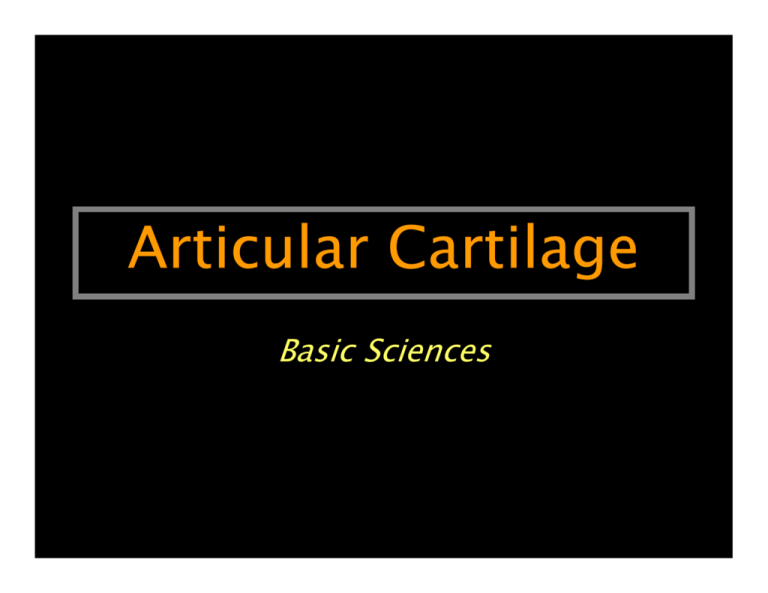
Articular Cartilage Basic Sciences Articular Cartilage: Location Articular cartilage covers the joint surfaces: •Bottom of the femur •Top of the tibia •Back-side of the patella Articular Cartilage: Primary Functions • Transmits applied loads across mobile surfaces • Lines the ends of bones • surfaces roll or slide during motion – Hyaline cartilage is fluid-filled wear-resistant surface – It reduces friction coefficient to 0.0025. Articular Cartilage: Anatomy 1. Quadriceps femoris 2. Patellar tendon 3. Suprapatellar bursa 4. Patella 5. Joint cavity 6. Infrapatellar fat pad 7. Tibia 8. Meniscus 9. Articular cartilage 10. Femur Photo of knee joint cross section. The white tissue is the articular cartilage covering the distal femur (top) and proximal tibia (bottom) bone surfaces. Articular Cartilage: Histology By volume: 1% chondrocytes and 99% matrix •Chondrocytes produce collagen, proteoglycans, etc. as needed •Release enzymes to break down aging components. Articular Cartilage: Chondrocytes  Chondrocytes vary in size, morphology and arrangement  Changes with depth at tissue Articular Cartilage: Chondrocytes Articular Cartilage: Chondrocytes Cells from surface to deeper levels: •Flatter Æ Rounder •Scattered Æ Organized into columns •Below tidemark, cells are encrusted with apatite salts (bone) Articular Cartilage: Composition Note that articular (hyaline) cartilage has the highest proportion of water and also the highest proteoglycan content Articular Cartilage: Composition Components are arranged in a way that is maximally adapted for biomechanical functions •Chondrocytes (~ 1%) •Collagen (15%) (Type II in articular cartilage) •Proteoglycans (15%) •Water (70 %) Collagen (15%) Creates a framework that houses the other components of cartilage •Majority is Type II collagen •Provides cartilage with its tensile strength Look at Ligament & Tendon notes for structure of collagen fibers Proteoglycans (15%)  Each subunit consists of a combination of protein and sugar: Long protein chain ÂSugars units attached densely in parallel Proteoglycans (15%)  Subunits are attached at right angles to a long filament  Produce a macromolecules: the proteoglycan aggregate Proteoglycans (15%) Proteoglycans (15%)  Each sugar has one or two negative charges, so collectively there is an enormous repulsive force within each subunit and between neighboring subunits  This causes the molecule to extend stiffly out in space  This property gives articular cartilage its resiliency to compression  The negative charges make the molecules extremely hydrophilic and cause water to be trapped within  It is used during biomechanical or lubricant activity. ÂW t f ti th " h k Mechanical Behavior Lateral Condyle COMPRESSIVE AGGREGATE MODULUS (MPa) POISSON’S RATIO PERMEABILITY COEFFICIENT (10-15m4/N•s) Patellar Groove 0.70 0.53 0.10 1.18 0.00 2.17 Tensile Force ³ Toe region: collagen fibrils straighten out and un- “crimp” ³ Linear region that parallels the tensile strength of collagen fibrils: collagen aligns with axis of tension ³ Failure region Tensile Force A.) Random alignment of collagen fibrils B.) Histogram of measurements made from micrograph show distribution of fibril alignment Shear Force Creep behavior Creep of a viscoelastic material under constant loading Stress rise during a ramp displacement compression of a visco-elastic material and stress relaxation under constant compression Compressive force •Rate of creep is determined by the rate at which fluid may be forced out of the tissue •This, in turn, is governed by the permeability and stiffness of the porouspermeable collagenproteoglycan solid matrix Permeability •Articular cartilage shows nonlinear strain dependence and pressure dependence •The decrease of permeability with compression acts to retard rapid loss of interstitial fluid during high joint loadings Permeability Permeability decreases in an exponential manner as function of both increasing applied compressive strains and increasing applied pressure Compressive force Copious exudation of fluid at start but the rate of exudation decreases over time from points A to B to C Compressive force At equilibrium, fluid flow ceases and the load is borne entirely by the solid matrix (point C) Compressive force Creep behavior of collagen-proteoglycan matrix is analagous to an elastic spring Creep behavior Creep of a viscoelastic material under constant loading Stress rise during a ramp displacement compression of a visco-elastic material and stress relaxation under constant compression Stress Relaxation The sample is compressed to point B and then maintained over time (points B to E) Stress Relaxation Increase stress to reach end of compressive phase Stress Relaxation Fluid redistribution allows for relaxation phase (points B to D) and matrix deformation Stress Relaxation Equilibrium is reached at point E

